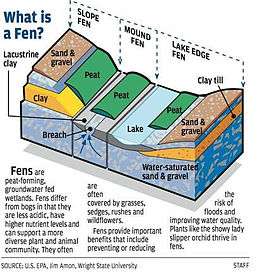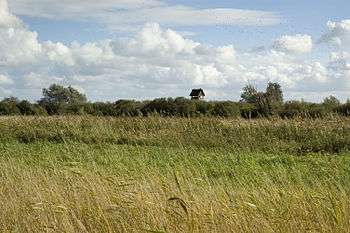Fen

A fen is one of the main types of wetland, the others being grassy marshes, forested swamps, and peaty bogs. Along with bogs, fens are a kind of mire. Fens are usually fed by mineral-rich surface water or groundwater.[1] They are characterised by their water chemistry, which is pH neutral or alkaline, with relatively high dissolved mineral levels but few other plant nutrients. They are usually dominated by grasses and sedges, and typically have brown mosses in general including Scorpidium or Drepanocladus.[2] Fens frequently have a high diversity of other plant species including carnivorous plants such as Pinguicula.[3][4] They may also occur along large lakes and rivers where seasonal changes in water level maintain wet soils with few woody plants.[5] The distribution of individual species of fen plants is often closely connected to water regimes and nutrient concentrations.[6][7]
Fens have a characteristic set of plant species, which sometimes provide the best indicators of environmental conditions. For example, fen indicator species in New York State include Carex flava, Cladium mariscoides, Potentilla fruticosa, Pogonia ophioglossoides and Parnassia glauca.[8]
Fens are distinguished from bogs, which are acidic, low in minerals, and usually dominated by sedges and shrubs, along with abundant mosses in the genus Sphagnum.[2]
Fens have been damaged in the past by land drainage, and also by peat cutting.[9] Some are now being carefully restored with modern management methods.[10] The principal challenges are to restore natural water flow regimes, to maintain the quality of water, and to prevent invasion by woody plants.
Vegetation
Carr is the northern European equivalent of the wooded swamp of the southeastern United States,[11] also known in the United Kingdom as wet woodland. It is a fen overgrown with generally small trees of species such as willow (Salix spp.) or alder (Alnus spp.). In general, fens may change in composition as peat accumulates. A list of species found in a fen can therefore cover a range of species from those remaining from the earlier stage in the successional development to the pioneers of the succeeding stage.
Where streams of base-rich water run through bog, these are often lined by strips of fen, separating "islands" of rain-fed bog.
Temporary flooding by beavers can have negative effects on fens.[12]
Use of term in literature
Shakespeare used the term "fen-sucked" to describe the fog (literally: rising from marshes) in King Lear, when Lear says "Infect her beauty, You fen-sucked fogs drawn by the powerful sun, To fall and blister."[13]
Images
- Avaste Fen is one of the biggest fens in Estonia and has a territory of 88 km2
 View of Wicken Fen showing vegetation typical of a fen in the foreground and carr vegetation featuring trees and bushes in the background
View of Wicken Fen showing vegetation typical of a fen in the foreground and carr vegetation featuring trees and bushes in the background
See also
Specific fens
- Wicken Fen, Cambridgeshire
- The Fens (eastern England)
- Mesopotamian Marshes (Iraq)
- Back Bay Fens (Boston, Massachusetts)
- Cedar Bog (Champaign County, Ohio)
- Cowles Bog, Indiana Dunes National Lakeshore (Indiana, USA)
- Geneva Creek (Colorado) (an iron fen in the USA)
References
- ↑ Godwin et al. (2002).
- 1 2 Keddy (2010), p. 8.
- ↑ Wheeler & Giller (1982)
- ↑ Keddy (2010), Chapter 9.
- ↑ Charlton & Hilts (1989)
- ↑ Slack et al. (1980)
- ↑ Schröder et al. (2005)
- ↑ Godwin et al. (2002), Table 3.
- ↑ Sheail & Wells (1983)
- ↑ Keddy (2010), Chapter 13.
- ↑ Bug Life
- ↑ Reddoch & Reddoch (2005)
- ↑ William Shakespeare (2008). "King Lear, Act II, Scene IV, line 162". Penguin Books. Retrieved 5 September 2015.
poem stripmarker inYou nimble lightnings, dart your blinding flames, Into her scornful eyes! Infect her beauty, You fen-sucked fogs drawn by the powerful sun, To fall and blister.
|quote=at position 1 (help)
Bibliography
- Charlton, D. L.; S. Hilts (1989). "Quantitative evaluation of fen ecosystems on the Bruce Peninsula". In M. J. Bardecki; N. Patterson. Ontario Wetlands: Inertia or Momentum. Toronto, ON: Federation of Ontario Naturalists. pp. 339–354. Proceedings of Conference, Ryerson Polytechnical Institute, Toronto, Oct 21–22, 1988.
- Godwin, Kevin S., James P. Shallenberger, Donald J. Leopold & Barbara L. Bedford (2002). "Linking landscape properties to local hydrogeologic gradients and plant species occurrence in New York fens: a hydrogeologic setting (HGS) framework". Wetlands. 22 (4): 722–737. doi:10.1672/0277-5212(2002)022[0722:LLPTLH]2.0.CO;2.
- Keddy, P. A. (2010). Wetland Ecology: Principles and Conservation (2nd ed.). Cambridge, UK: Cambridge University Press.
- Reddoch, Joyce M.; Allan H. Reddoch (2005). "Consequences of Beaver, Castor canadensis, flooding on a small shore fen in southwestern Quebec". Canadian Field-Naturalist. 119 (3): 385–394.
- Schröder, Henning K., Hans Estrup Andersen & Kathrin Kiehl (2005). "Rejecting the mean: estimating the response of fen plant species to environmental factors by non-linear quantile regression". Journal of Vegetation Science. 16 (4): 373–382. doi:10.1111/j.1654-1103.2005.tb02376.x. JSTOR 4096617.
- Sheail, J.; T. C. E. Wells (1983). "The Fenlands of Huntingdonshire, England: a case study in catastrophic change". In A. J. P. Gore. Mires: Swamp, Bog, Fen and Moor – Regional Studies. Ecosystems of the World. 4B. Amsterdam, the Netherlands: Elsevier. pp. 375–393. ISBN 9780444420046.
- Slack, Nancy G., Dale H. Vitt & Diana G. Horton (1980). "Vegetation gradients of minerotrophically rich fens in western Alberta". Canadian Journal of Botany. 58 (3): 330–350. doi:10.1139/b80-034.
- Wheeler, B. D.; K. E. Giller (1982). "Species richness of herbaceous fen vegetation in Broadland, Norfolk in relation to the quantity of above-ground plant material". Journal of Ecology. 70 (i): 179–200. JSTOR 2259872.
External links
-
 Media related to Fens at Wikimedia Commons
Media related to Fens at Wikimedia Commons